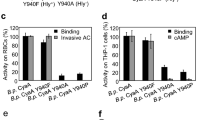Abstract
Clostridium perfringens epsilon toxin (Etx) is an extremely potent toxin, causing fatal enterotoxaemia in many animals. Several amino acids in domains I and II have been proposed to be critical for Etx to interact with MDCK cells. However, the critical amino acids in domain III remain undefined. Therefore, we assessed the effects of aromatic amino acids in domain III on Etx activity in this study. All of the results indicated that Y71 was critical for the cytotoxic activity of Etx towards MDCK cells, and this activity was dependent on the existence of an aromatic ring residue in position 71. Additionally, mutations in Y71 did not affect the binding of Etx to MDCK cells, indicating that Y71 is not a receptor binding site for Etx. In summary, we identified an amino acid in domain III that is important for the cytotoxic activity of Etx, thereby providing information on the structure-function relationship of Etx.
Similar content being viewed by others
References
Bokori-Brown, M., Kokkinidou, M.C., Savva, C.G., Fernandes da Costa, S., Naylor, C.E., Cole, A.R., Moss, D.S., Basak, A.K., and Titball, R.W. 2013. Clostridium perfringens epsilon toxin H149A mutant as a platform for receptor binding studies. Protein Sci. 22, 650–659.
Bokori-Brown, M., Savva, C.G., Fernandes da Costa, S.P., Naylor, C.E., Basak, A.K., and Titball, R.W. 2011. Molecular basis of toxicity of Clostridium perfringens epsilon toxin. FEBS J. 278, 4589–4601.
Borrmann, E., Gunther, H., and Kohler, H. 2001. Effect of Clostridium perfringens epsilon toxin on MDCK cells. FEMS Immunol. Med. Microbiol. 31, 85–92.
Cole, A.R., Gibert, M., Popoff, M., Moss, D.S., Titball, R.W., and Basak, A.K. 2004. Clostridium perfringens epsilon-toxin shows structural similarity to the pore-forming toxin aerolysin. Nat. Struct. Mol. Biol. 11, 797–798.
Ivie, S.E. and McClain, M.S. 2012. Identification of amino acids important for binding of Clostridium perfringens epsilon toxin to host cells and to HAVCR1. Biochemistry 51, 7588–7595.
Killian, J.A. and von Heijne, G. 2000. How proteins adapt to a membrane-water interface. Trends Biochem. Sci. 25, 429–434.
Lindsay, C.D., Hambrook, J.L., and Upshall, D.G. 1995. Examination of toxicity of Clostridium perfringens-toxin in the MDCK cell line. Toxicol. In Vitro 9, 213–218.
McDonel, J.L. 1986. Toxins of Clostridium perfringens types A, B, C, D and E, pp. 477–517. In F. Dorner, J.D. (ed.), Pharmacology of bacterial toxins. Pergamon Press, Oxford.
Minami, J., Katayama, S., Matsushita, O., Matsushita, C., and Okabe, A. 1997. Lambda-toxin of Clostridium perfringens activates the precursor of epsilon-toxin by releasing its N- and C-terminal peptides. Microbiol. Immunol. 41, 527–535.
Miyamoto, O., Sumitani, K., Nakamura, T., Yamagami, S., Miyata, S., Itano, T., Negi, T., and Okabe, A. 2000. Clostridium perfringens epsilon toxin causes excessive release of glutamate in the mouse hippocampus. FEMS Microbiol. Lett. 189, 109–113.
Miyata, S., Minami, J., Tamai, E., Matsushita, O., Shimamoto, S., and Okabe, A. 2002. Clostridium perfringens epsilon-toxin forms a heptameric pore within the detergent-insoluble microdomains of Madin-Darby canine kidney cells and rat synaptosomes. J. Biol. Chem. 277, 39463–39468.
Nagahama, M., Ochi, S., and Sakurai, J. 1998. Assembly of Clostridium perfringens epsilon-toxin on MDCK cell membrane. J. Nat. Toxins 7, 291–302.
Oyston, P.C., Payne, D.W., Havard, H.L., Williamson, E.D., and Titball, R.W. 1998. Production of a non-toxic site-directed mutant of Clostridium perfringens epsilon-toxin which induces protective immunity in mice. Microbiology 144, 333–341.
Payne, D. and Oyston, P. 1997. The Clostridium perfringens ε-toxin, pp. 439–447. In Rood, J.I., M.B.A., Songer, J.G., and Titball, R.W. (ed.), The clostridia: molecular biology and pathogenesis. Academic Press, London, United Kingdom.
Pelish, T.M. and McClain, M.S. 2009. Dominant-negative inhibitors of the Clostridium perfringens epsilon-toxin. J. Biol. Chem. 284, 29446–29453.
Petit, L., Gibert, M., Gillet, D., Laurent-Winter, C., Boquet, P., and Popoff, M.R. 1997. Clostridium perfringens epsilon-toxin acts on MDCK cells by forming a large membrane complex. J. Bacteriol. 179, 6480–6487.
Petit, L., Maier, E., Gibert, M., Popoff, M.R., and Benz, R. 2001. Clostridium perfringens epsilon toxin induces a rapid change of cell membrane permeability to ions and forms channels in artificial lipid bilayers. J. Biol. Chem. 276, 15736–15740.
Popoff, M.R. 2011. Epsilon toxin: a fascinating pore-forming toxin. FEBS J. 278, 4602–4615.
Robertson, S.L., Li, J., Uzal, F.A., and McClane, B.A. 2011. Evidence for a prepore stage in the action of Clostridium perfringens epsilon toxin. PLoS One 6, e22053.
Soler-Jover, A., Blasi, J., Gomez de Aranda, I., Navarro, P., Gibert, M., Popoff, M.R., and Martin-Satue, M. 2004. Effect of epsilon toxin-GFP on MDCK cells and renal tubules in vivo. J. Histochem. Cytochem. 52, 931–942.
Songer, J.G. 1996. Clostridial enteric diseases of domestic animals. Clin. Microbiol. Rev. 9, 216–234.
Tsitrin, Y., Morton, C.J., el-Bez, C., Paumard, P., Velluz, M.C., Adrian, M., Dubochet, J., Parker, M.W., Lanzavecchia, S., and van der Goot, F.G. 2002. Conversion of a transmembrane to a watersoluble protein complex by a single point mutation. Nat. Struct. Biol. 9, 729–733.
Uzal, F.A. and Songer, J.G. 2008. Diagnosis of Clostridium perfringens intestinal infections in sheep and goats. J. Vet. Diagn. Invest. 20, 253–265.
Worthington, R.W. and Mulders, M.S. 1977. Physical changes in the epsilon prototoxin molecule of Clostridium perfringens during enzymatic activation. Infect. Immun. 18, 549–551.
Author information
Authors and Affiliations
Corresponding author
Rights and permissions
About this article
Cite this article
Jiang, Z., Chang, J., Wang, F. et al. Identification of tyrosine 71 as a critical residue for the cytotoxic activity of Clostridium perfringens epsilon toxin towards MDCK cells. J Microbiol. 53, 141–146 (2015). https://doi.org/10.1007/s12275-015-4523-8
Received:
Revised:
Accepted:
Published:
Issue Date:
DOI: https://doi.org/10.1007/s12275-015-4523-8




